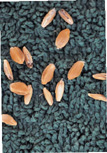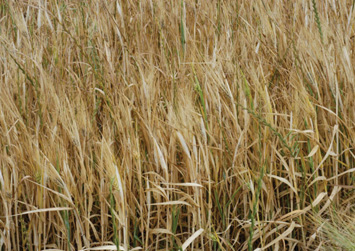

The tares, in this case Lolium temulentum, are the narrower grains. The wheat, the wider grains, is a variety of durum and is larger than grains of emmer wheat, which was the most widely cultivated wheat in ancient times.
“SEPARATING WHEAT FROM TARES” is a common expression based on one of the better-known parables of Jesus. But what is this plant, zizanion in Greek, mentioned only in Matthew 13? The Greek word has been variously translated as tares, darnel, and simply weeds.
While agricultural weeds are cited in several verses in the Old Testament (Job 31:40; Proverbs 24:31; Hosea 10:4), weeding of crops is not mentioned in the Bible and was apparently not practiced for grain crops in Egypt (Murray 2000). The weeds were simply allowed to mature with the crop, like the tares, and were harvested along with the crop and used as fodder or fuel.
The two most likely candidates for tares are common segetals (weeds associated with crops) in the Middle East. The first is Cephalaria syriaca, related to the attractive garden scabiosa, which are grown for their colorful flowers (actually aggregations of flowers) and decorative fruiting heads. Cephalaria syriaca is restricted in its range, while the other candidate, Lolium temulentum, is found throughout much of the world both as a weed and a pasture crop. No grasses are known to be toxic, so it may seem surprising that L. temulentum has frequently been implicated in cattle poisoning and, rarely, human poisoning (Hammouda et al. 1988) due to the presence of a toxic microorganism.
Cephalaria syriaca, Syrian scabiosa, in a wheat field in June, near Medaba, Jordan. The developing fruits are formed at the same height as the grain.

Lolium temulentum, darnel, in May, near Latakia, Syria. The tares are the green stems.
Cephalaria syriaca is an annual that reaches a height of 1.3 meters (4 feet) with a single stem that branches to produce numerous heads of flowers. The flowers are much less attractive than those of many members of the family and produce a small, hard seed (technically a fruit) with a very bitter taste. Despite the bitterness, the fruit is not toxic and has potential as a source of vegetable oil (Yazicio lu et al. 1978). In the Middle East, this plant is found in the driest places where wheat is grown.
lu et al. 1978). In the Middle East, this plant is found in the driest places where wheat is grown.
On the other hand, darnel, Lolium temulentum, is a grass, which like Cephalaria syriaca grows to the same height as a mature wheat plant and is often found growing in wheat fields. The grains are similar in size to those of wheat. It is a classic segetal plant.
The association of tares with wheat requires a closer look in the spot where the plant is mentioned: “The Kingdom of Heaven is like a farmer who planted good seed in his field. But that night as the workers slept, his enemy came and planted weeds among the wheat, then slipped away. When the crop began to grow and produce grain, the weeds also grew. The farmer’s workers went to him and said, ‘Sir, the field where you planted that good seed is full of weeds! Where did they come from?’ ‘An enemy has done this!’ the farmer exclaimed. ‘Should we pull out the weeds?’ they asked. ‘No,’ he replied, ‘you’ll uproot the wheat if you do. Let both grow together until the harvest. Then I will tell the harvesters to sort out the weeds, tie them into bundles, and burn them, and to put the wheat in the barn’” (Matthew 13:24–30, NLT).
Unlike the other six parables in this chapter, the following required unpacking by the Teacher: “Then, leaving the crowds outside, Jesus went into the house. His disciples said, ‘Please explain to us the story of the weeds in the field.’ Jesus replied, ‘The Son of Man is the farmer who plants the good seed. The field is the world, and the good seed represents the people of the Kingdom. The weeds are the people who belong to the evil one. The enemy who planted the weeds among the wheat is the devil. The harvest is the end of the world, and the harvesters are the angels. Just as the weeds are sorted out and burned in the fire, so it will be at the end of the world. The Son of Man will send his angels, and they will remove from his Kingdom everything that causes sin and all who do evil. And the angels will throw them into the fiery furnace, where there will be weeping and gnashing of teeth. Then the righteous will shine like the sun in their Father’s Kingdom. Anyone with ears to hear should listen and understand!’” (Matthew 13:36–43, NLT).
If this parable is to be understood, we have to scrutinize the text. First, tares are associated with wheat, not with the other dominant ancient grain, barley. Contamination of the seed is implied. And it is obvious that the weed has a life cycle that is synchronous with the wheat. Put another way, tares are segetal plants in wheat fields. When the wheat nears maturity it is clearly evident that the weed and the wheat plants can be distinguished. How does this background help us determine which plant is zizanion? There is evidence from indigenous peoples.
Local Arab farmers in Jordan, Lebanon, and Syria refer to a weed that grows with wheat by the Arabic name zawan. This pejorative word describes an undesirable weed associated with wheat (Musselman 2001). The weed is enshrined in a proverb, “The zawan of your own field is better than the wheat of the crusaders,” often applied to people seeking wives from more distant places rather than their own villages. Greppin (1995) also states that zawan refers to Lolium temulentum in Arabic.
In Jordan, zawan is clearly Cephalaria syriaca. Farmers state unequivocally that it occurs only in wheat, not in barley. However, farmers in higher rainfall areas of Lebanon and Syria use the term zawan for Lolium temulentum. And other plants are also considered candidates for tares (Musselman 2001).
Translating zizanion as “thistle,” as in the MSG, seems to miss the teaching of the parable that the intruder resembles or imitates the crop, which is certainly not the case with thistles.